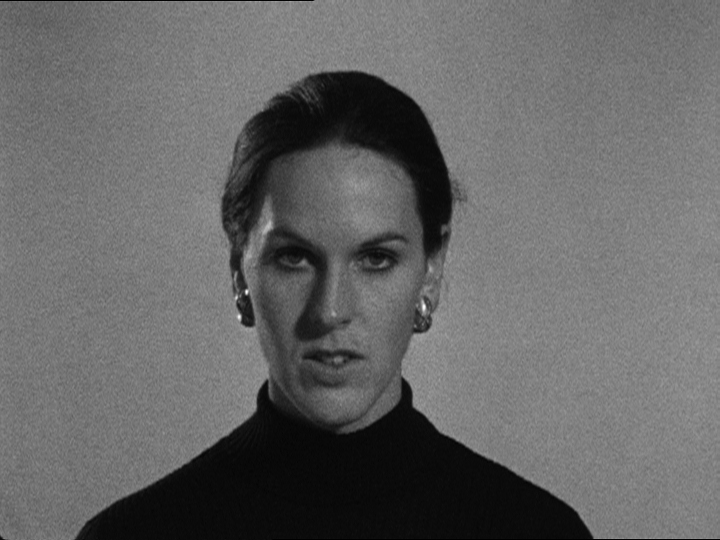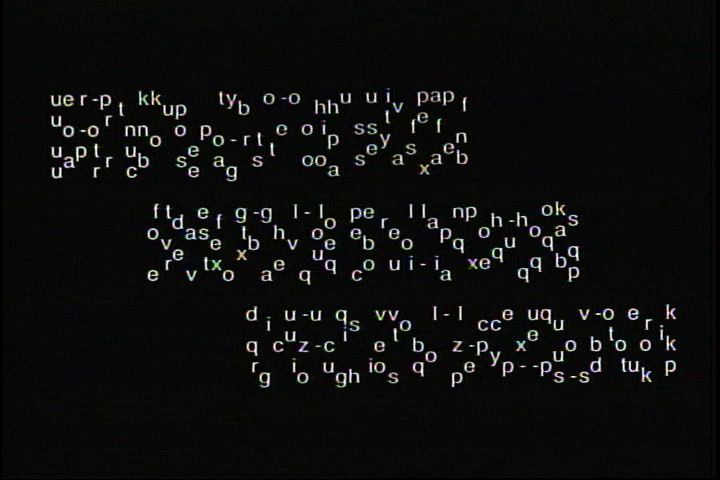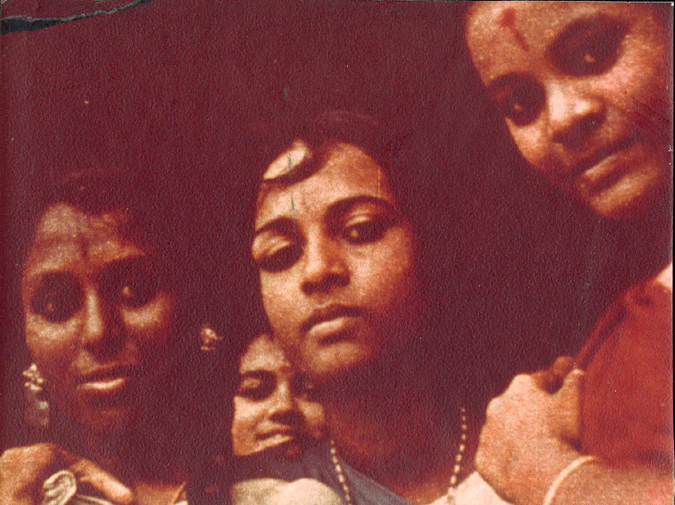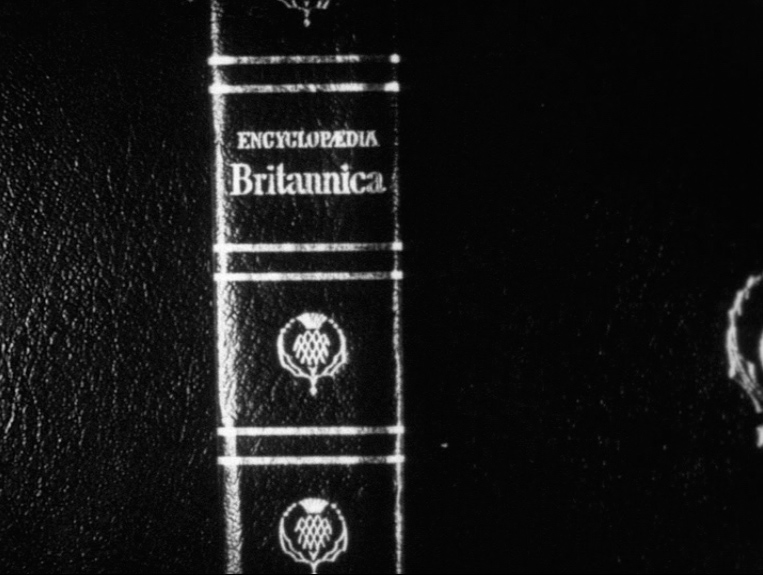TIME AND LANGUAGE
19 November 2008
A screening of artists' film on the nature of time and language; their loops, slips and knots. Including work by David Lamelas, Hollis Frampton, John Latham, Peter Rose and John Smith.
The five works in this screening all deal with some kind of breakdown or re-ordering of language and its component parts. Some of them challenge the associations between language and objects; or the links between language and memory. Others more generally highlight the mutability of language and its shortcomings as a system of communication.
David Lamelas, Reading film from Knots by R.D. Laing
1970, sound, colour, 15 mins, 16mm
R.D. Laing is known for his radical psychiatry, practiced at Kingsley Hall in London during the 1960s. His book "Knots" (also 1970) looks at the ways in which people communicate and misunderstand each other. It sits somewhere between psychology, poetry and philosophy as a piece of literature. Laing converts case studies of real-life instances of human interaction into complex verbal loops and binds. Lamelas' film Reading Film from "Knots" by R. D. Laing is divided into two sections. In the first, pages from "Knots" can read from the screen. In the second section a woman reads the same passages aloud. Lamelas offers different means of taking on board the information, or different ways of reading: we read from the screen, we are read to, and we attempt to read the almost deadpan delivery of the female narrator. This layering of media mimics the layering of language in Laing's text.
John Latham, Encyclopedia Britannica
UK, 1971, silent, B&W, 6 mins, 16mm
In Latham's lexicon books are the apparatus of learnt knowledge and of received opinion. As such, he saw them as belonging to a rational tradition that stifles intuition and creative thinking. Reliance on the past to solve the new problems of the present and the future was flawed in Latham's view, and reference books such as dictionaries or encyclopedia were particularly representative of this tendency. Encyclopedia Britannica is a stop-frame animation documenting an entire 32-volume set of the Encyclopedia Britannica, one page for every frame of film. The film becomes increasingly over-exposed as the film goes on. The acceleration and obfuscation of the text and images alludes to the difficulties in processing or 'taking on' knowledge received in this form; "the history of human knowledge becomes an illegible, strobing stream of images" (Lux).
Peter Rose, Secondary Currents *
USA, 1982, sound, B&W, 15 mins, 16mm
Secondary Currents is a film about the relationships between the mind and language. Delivered by an improbable narrator who speaks an extended assortment of nonsense, it is an 'imageless' film in which the shifting relationships between voice-over commentary and subtitled narration constitute a peculiar duet for voice, thought, speech, and sound. A kind of comic opera, the film is a dark metaphor for the order and entropy of language and has been the subject of a number of articles on the use of language in the arts.
Percussion by Jim Meneses.
Hollis Frampton, Nostalgia *
USA, 1971, sound, B&W, 36 mins, 16mm
"As its name suggests, Nostalgia is autobiographical. Its maker, Hollis Frampton, is recognised as one of the leading figures of the New American Cinema, a contemporary of Michael Snow, Paul Sharits and George Landow. This film, made in 1971 and itself part of a larger work called Hapax Legomena relates to a period between 1958 and 1966 - before Frampton was known as a film-maker and was working mainly in still photography. Twelve photographs are presented as 'documents' of that period. A number are of friends in the New York art world, others are images that were of aesthetic interest. The tone throughout is dry and ironic. Each photograph is presented to the camera and a voice, speaking in the first person, describes the content of the image, the personal circumstances that surround it and the memories it evokes. After a minute or so when the commentary has ceased, each photograph gradually curls up and burns, transformed into black ash by the hotplate on which each in turn is placed. The structure of the film is complicated by the fact that the commentary for each image is 'out of synch': each commentary fits the photograph to follow not the one before our eyes. The spectator himself is thus caught up in the process of memory and prediction that are the subject of the film."
John Smith, Associations *
UK, 1975, sound, colour, 7 mins, 16mm & video
"Images from magazines and colour supplements accompany a spoken text taken from 'Word Associations and Linguistic Theory' by Herbert H. Clark. By using the ambiguities inherent in the English language, Associations sets language against itself. Image and word work together/against each other to destroy/create meaning." (J.S. from http://www.lux.org.uk)
"On the one hand, Associations is a highly structured, hermetic work in which an academic voice reads an excerpt from a book on linguistic theory, discussing how people associate words with other words. Smith sets ups his own humorous parallel associations, using images to stand in for words, and sometimes the syllables of words, uttered by the speaker. The images are banal ones, taken from colour supplements and popular magazines. The film comprises black leader with bursts of images appearing in clusters. For example, the utterance 'associations' is represented by images of an ASS, a SEWing machine, the SEA and a group of ASIANS. More obliquely, the image of a judge accompanies the utterance 'sentences'. It is a film of semantic wit, word-play and visual punning."
(Michael O'Pray)
* Texts reproduced courtesy of Lux from http://www.lux.org.uk

David Lamelas Reading film from 'Knots' by R.D. Laing (1970) Sound, colour, 15', 16mm. Image courtesy the artist/LUX London

Peter Rose Secondary Currents (1982) Sound, B&W, 15', 16mm. Image courtesy the artist/LUX London

John Smith Associations (1975) Sound, colour, 7', 16mm & video. Image courtesy the artist/LUX London

John Latham Encyclopedia Britannica (1971) Silent, B&W, 6', 16mm. Image courtesy the artist/LUX London.